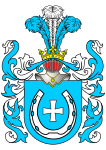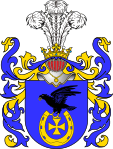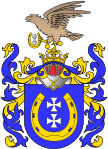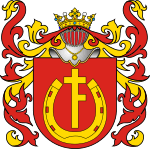Jastrzębiec coat of arms
| Jastrzębiec | |
|---|---|
 | |
| Details | |
| Battle cry | Bolesta, Kamiona, Lubrza, Łazęka, Nagody, Nagórę, Zarazy |
| Alternative names | Accipiter, Bolesta, Boleścic, Jastrząb, Jastrząbek, Kamiona, Łazęka, Lubrza |
| Earliest mention | 1319 (seal) |
| Families |
Abicht, Abrahamowicz, Abramowicz, Abramowski, Adamczewski, Adamczowski, Adamowski, Adamski, Ajdukiewicz, Akreyć, Albinowski, Anasiński, Andralewski, Andrejkonis, Andrzejkonis, Antuziński, Ardzienicki, Arkuszewski. |
| Cities | Bychawa, Konopnica (village) |
| Gminas | Gmina Konopnica, Gmina Rytwiany |
Jastrzębiec is a Polish Coat of Arms. It was used by several szlachta families prior to and during the Polish-Lithuanian Commonwealth, and to the present day. During World War II and the communism reform, many families lost their commonwealth status, and to this day have no right to their manors and sometimes vast lands.
History
Legend of the Coat of Arms
According to Bartosz Paprocki ("Gniazdo cnoty..." from 1578),[2] this armorial bearing has the name Jastrzebiec because the clan's ancestors, while still pagans, bore on the arms only a Goshawk (Jastrzab). But later, in the days of King Boleslaw the Brave, circa 999, when pagan foes were masters of Łysa Góra - two miles from Bozecin, now called Swiety Krzyz (Holy Cross) and stood secure upon it as if in a fortress, they hurled abuse upon our forces, saying: "Send forth one from among you who is willing to fight for Christ in a challenge against one of our men." Having heard this a knight, one Jastrzebczyk scion of the Jastrzebiec clan, moved by the fervor of faith and the praise of God, invented shoes for the horses' hooves and, having shod a horse with them, succeeded in forcing his way up the mountain. He fought the Pagan, who had hitherto been jeering haughtily, captured him, and brought him to the King. After he had given the other soldiers of the Polish cavalry this method, when they had shod their horses and made their way up the slippery mountain, covered with ice, they destroyed and defeated the enemy. As a reward for his ingenuity he received from that King a variation of his arms, adding a horschoe with a cross to the shield and elevating the Goshawk to the helmet. This is what Paprocki and all others who wrote about these arms say.
I, however, can not verify these authors' notion that this Jastrzebczyk in 999 was the first among us in Poland to invent the horseshoe and shoeing horses. For it is clear from antiquity that as early as Poppea (whose death in the days of Nero is described by Tacitus, an. 16 Ulyss. Aldr. de quadrup. lib. 1) she had her horse shod with silver shoes, and it is known that others before her used iron shoes, and I have mentioned vol 2, fol. 95 of Balbin, Czech Historian, that in Bohemia around the year 278 A.D. there was a house which used a seal with three horsehoes, and as he says, came with Czech to that country. And here in Poland Leszek the Traitor, vying on the Pradnik field covered with barbs to get to a crown hung on a pillar, had his horse shod, Cromer lib. 2, and a foreign author also takes him to be the inventor of horseshoes, Szentivani in Curios. It is true, one might say that our people did not use shoes for horses up to that time (which Cromer explicitly says of the days of Leszek II), and this Jastrzebczyk renewed this practice on the occasion already mentioned. Except it was Paprocki - who in Gniazdo cnoty was the first of the authors to give this origin of the Jastrzebiec arms, about which it has been told ever since - who dated those origins in the days of Boleslaw the Brave. But in a later book he produced, to which he gave the title of Stromata, it was quite different: the first author of Belina arms was survived by three sons, who agreed among themselves that the oldest of them would use three horseshoes in his arms, as we see in Belina arms; the second would use two, in the form seen in Lzawa arms; and the third would use one, as in Jastrzebiec arms. But he supports neither the first nor the second version by citing any author. It would be better to say that these arms came to Poland with Lech, and after one of the earlier members of his house was baptized he added the cross to it. Nonetheless, as to the antiquity of this house, and the fact that it flourished in pagan times in the Poland of the monarchs, all the authors agreed, and some add that one of the Jastrzebczyks was among the twelve voivodes who at two different times ruled the whole country. In Stromata Paprocki affirms that one member of this family was in foreign lands and converted to Christianity there, and this was the cause of the Polish prince Mieczyslaw's Mieszko conversion.[2]
The antiquity of the Jastrzebczyks is also evident in that no arms have more families using them than all the ones using Jastrzebiec: and Paprocki says in "0 herbach" that several hundred years ago they called themselves simply Jastrzebczyks, and it was not until after the days of Archbishop Wojciech of Gniezno that the foremost ones of this house began to write "z Rytwian" (from Rytwiany), and others named themselves after whatever estate they possessed. The antiquity is also evident from the fact that many other arms took their origin from Jastrzębiec, such as Dąbrowa, Zagłoba, Pobóg, and others. These arms are also called "Boleszczyc", in Silesia and in Mazovia "Lazanki"; in other places Jastrzebczyks are called by names from what they call the goshawk, "Kaniowa" or "Kudbrzowa". In Paprocki's day there was a Jastrzebiec castle, in the inheritance of the Zborowskis; Piotr Zborowski from Rytwiany, Kraków voivode and general, tore it down, dug it out, and had a large pond put in its place.
Ancestors of this House
Based on a grant of privilege to a monastery, Paprocki cites as the most ancient member of this house Mszczuj, Sandomierz castellan, in 999, the time of Boleslaw the Brave; his two sons Mszczuj and Jan, who signed their names as "from Jakuszewice," were Kraków canons, made such by Bishop Lambert in 1061. Other historians write of this as well. Dlugosz in 1084 recalls those Jastrzebczyks who came from Hungary, with Mieczyslaw, son of Boleslaw the Bold, based on the writings of the monarch Wladyslaw, his uncle - that is Borzywoj, Mszczuj's son, Zbylut, Dobrogost, Zema, Odolaj, Jedrzej - and he returned all the estates confiscated from them for the killing of St. Stanislaw the Bishop.
Derszlaw was cupbearer for King Boleslaw Wry-mouth in 1114, and Boleslaw the Curly granted a title to the villages Jakuszewice and Kobelniki to his sons Wojciech and Derszlaw, of whom Wojciech was the Sandomierz standard-bearer. Paprocki cites a fragment of his in "0 herbach", but the long stretch of time between them and their father, i. e., 166 years, does not permit me to believe that they were sons of Derszlaw the cupbearer. Paprocki cites a monastery grant of privilege given in 1199 for Borzywoj and Derszlaw Jastrzebczyk, heirs to Jakuszowice. He also includes Piotr, son of Wojciech, Sandomierz standard-bearer.
Swentoslaw, from the post of Poznań pastor and Gniezno canon, was chosen to be bishop of Poznan; and in truth already of an advanced age, he had broken free of his pastoral burden, but he yielded to those urging him and with his knowledge and by his example ruled the flock entrusted to him. But he spent only a year at this see before departing from this world in 1176 and was buried in the church. Nakiel. w Miechov. fol. 66, praises the good works of this Swietoslaw for his monastery, which he saved at its beginnings with his generous alms; he ascribes to him the Pobog arms; yet Długosz in "Vitae Episc. Posnan." and others call him a Jastrebczyk. Paprocki tells that in Jędrzejów is a grave from the year 1206 covered with a stone on which the Jastrzębiec arms are still visible, but the letters can no longer be read.
Piotr Brevis (brevis is Latin for "short") called Maly (small), nineteenth bishop of Plock, a Plock scholastic chosen by the chapter for that office, moved in the fifth year of his see to another, in 1254. Lubienski in "Vitae Episc. Plocens", however, ascribed no coat of arms to him, and said of him only that he lived of a noble clan, but Paprocki in "0 herbach" writes explicitly of him that he was a Jastrzebczyk.
Bishop Jan of Wrocław in Silesia, was the first of the Poles to ascend the episcopacy, inasmuch as only Italians had governed it previously; he was a Wrocław canon elected to that dignity in 1062, presided over it for 10 years, and went to his reward for his pastoral labors in 1072, as Dlugosz attests in his "Kronika" where he writes of him explicitly as of the Jastrzebiec clan. Jakób of Raciborowice, Sandomierz castellan, died at Chmielnik in 1241.
Michal, Kraków castellan 1225. Mistuj, Kraków voivode 1242. Scibor, Leczyca voivode 1242. Msciug, Sandomierz voivode 1342. These were discussed in the first volume in their own place. A letter of Kazimierz the Great, King of Poland, given to the Strzelno monastery, mentions inter praesentes Mszczuj, Kraków chamberlain. Pawel Koszcziena, who signed himself "z Sendziszowa," is in Dlugosz under 1899, and I will speak of this below.
Jedrzej, Bishop of Vilna, called "Vasilo" by the Lithuanians, truly an apostolic shepherd, in the days of King Władysław II Jagiełło in 1399 preached the Christian faith in Lithuania, at that time still unbelieving. Kromer calls him a learned and God-fearing man. Marcisz, brother of Bishop Jedrzej, endowed the Franciscan Fathers with a monastery made of brick in Nowe Miasto, and he also bought Zborów, from which came the Zborowskis.
Wojciech the Archbishop of Gniezno; his father was Derszlaw and mother Krystyna, and he was born in the village Lubnica among numerous other offspring. When his father, possessed of a meager fortune, accompanied him to the Bensowa parish church for instruction, and gave him up to the institution, according to the Dlugosz in "Vitae Episcop. Posnan.", he spoke thus to him. "I give you up, my son, not into the ranks of students but of bishops. Remember, when you have become a bishop, do not forget your current standing, in which you see both your mother and me, your brothers and sisters: this lack of means in which you were born is greater than could fade from your memory if you had the greatest fortune. When you become a bishop, do this for me, make a church of brick in this place where I give you up for schooling." His son listened to all of this and promised to fulfill the exhortation as a paternal order. The hopes of both did not deceive them, for Wojciech, rising in rank, became a priest, and soon from being a Kraków scholastic, as Dlugosz says, or from being a Kraków dean and Poznan pastor, he became the mitred prelate of Poznan in 1399; tearing down the wooden church in Bensowa, he had a brick one built in 1407, and later settled the friars of St. Paul the Hermit there, and gave it the villages of Bensowa, Bensowka, Bydlowa, and Bystronowice. Besides this he founded the collegiate church in Warsaw, and cathedral. Thus for 14 years he held that post at that church in a laudable manner, so that he was held in high regard by all, both for his wisdom, which appeared at its best in every chancellory function, and for the piety of his life. But he put himself under great strain when, having moved Piotr Wiss of Leszczyc arms from the Kraków episcopacy, he recalled him to that of Poznan through various practices and himself occupied his bishopric in 1412, although he had many quarrels because of it: for as soon as the matter arose at the Council of Konstanz it moved all the priests assembled there with compassion for Peter, and surely Wiss would have returned to his bishopric if he had not been taken by death at that point. Wojciech, more secure after his death, founded a city, having cut down the woods, and called it Jastrzebie, and he endowed and gave to it parish churches in Sandomierz province, one in Wysokie in Lublin district, the other in Kortynica in Sandomierz district. He designated a tithe for the Altar of St. Agnes in Kraków diocese. Then in 1423 he was elevated to the rank of metropolitan and primate, and left behind there a memory of his generosity. funding two benefices, one theological and one juridical, and a third in Kalisz. He set up an altar in Leczyca, returned regular canons to Klodawa, and named their church to the collegiate church, and left this world in 1436, an important, judicious man and a great lover of his country, as Dlugosz and Damalew. praised him in "Vitae Archiepisc. Gnesn." and "Starowol. in Vitae Episc. Cracov." He had amassed considerable money, which he left his successors, and while yet alive bought for them Rytwiany in Sandomierz district and Borzyslawice in Leczyca district, where he funded benefices for both these places. However there was suspicion of him to some extent, that the curate of the Poznań Cathedral had shown him the collection and treasury of the ancient Kings of Poland, of which the curates had passed on knowledge in secret, each to the next, until that time. From that time on his successors began to sign their names as "z Rytwian" (from Rytwiany): his brother was Scibor, Leczyca voivode, and he had twenty sons, and Paprocki saw all their portraits in the Bensowa church, but the signatures under them could not be read. Eight of them (i. e., the sons) were lost in the Prussian war, the other twelve were various castellans.[2]
Blazon
The following was prepared from the classic heraldic reference Herbarz Polski by Kasper Niesiecki, S J., Leipzig edition, 1839-1846.
For each herb [clan shield, coat of arms] the blazon or verbal description of the arms is first given in authentic heraldic style, followed by a translation from the Polish description by Niesiecki. The right and left sides of a shield are identified from the standpoint of the bearer, i. e., the one holding the shield. His right would be your left and vice versa. The tinctures (colors) in heraldry are as follows: azure = blue, gules = red; sable = black; or = gold, argent = silver; vert = green. In heraldry all charges (pictures) on a shield are assumed to be facing dexter (right side) unless otherwise specified. In Polish heraldry all animals or birds are assumed to be in their natural coloring unless otherwise specified.
Arms: azure, a horseshoe reversed, between its branches, a small cross patée en abime, both or. Upon a wreath of the colors mantled of his liveries whereon is set for a crest: out of a ducal coronet, a hawk proper, wings surgent, belled and jessed, holding in its dexter talons, a charge of the shield.
On a shield in a blue field is a gold horseshoe, with its heels pointed straight up, and in its center a cross; on the helmet over a crown is a Goshawk with its wings slightly raised for flight, facing the right side of the shield. On its legs are small bells and a leather strap, in its right talon it holds a horseshoe with cross, like those on the shield. Thus it is described by Paprocki 0 herbach, f., 115; Okolski, vol. 1, fol. 315; Potocki, Poczet herbów, fol. 117; Bielski, fol. 83; Kojalowicz, in MS.
Notable bearers
Notable bearers of this Coat of Arms include:
- Severin Severinovich Lawdanski
- Xawery Stanisław Czernicki
- Zygmunt Myszkowski
- Andrzej Niemirowicz
- Aleksander Hilary Polubiński
- Jan Rytwiański
- Edmund Taczanowski
- Władysław Taczanowski
- Kazimierz Wieslaw Mystkowski
- Nikolai Mystkowski
- Kazimierz Dziewanowski
- Zofia Dziewanowska
- Marcin Kunert-Dziewanowski known as Martin Kunert within the United States
- Both family
- Conrad Swan
- Aleksander Waszkowski
- Thomas G. Waszkowski, Jr.
- Jan Skrzetuski is a fictional character created by Polish author Henryk Sienkiewicz in the novel With Fire and Sword.
Towns and Counties
Gallery
Standard variations
-

Coat of Arms of Abrahamowicz (Abramowicz) family, 16th century
-

Ennoblement of Erazm Bełza in 1591 (According to Ostrowski)
-

Ennoblement of Erazma Bełzy in 1591 (According to Trelińska)
-

Coat of Arms of Białachowski family
-

Coat of Arms of Brzozowski family
-

Coat of Arms of Chyliński family
-

Coat of Arms of Ciborski family
-

Coat of Arms of Czernicki from Płock
-

Coat of Arms of Czernyszew family (Ukraine), 1765
-

Domaradzki II – variant Domaradzki
-

Coat of Arms of Dziengiel (Dzingel) family (Prussia).(According to Urski)
-

Coat of Arms of Gierałtowski family from Opole. (According to Ostrowski)
-

Coat of Arms of Gliszczyński family, 17th century
-

Coat of Arms of Grębecki family from Brześć-Kujawski 18th century
-

Coat of Arms of Bernard Jaczyński, 18th century
-

Jastrzębiec I – standard variation (According to Ostrowski)
-

Jastrzębiec III – variation (According to Ostrowski)
-

Jastrzębiec IV – Coat of Arms of Kierski, Konopnicki, Leszczyński and Zielonka families
-

Jastrzębiec V – Coat of Arms of Brzozowski and i Koczasski families
-

Jastrzębiec VI – Coat of Arms of Turłaj family (According to Ostrowski)
-

Coat of Arms of Kapica family from Powiat Bialski in Podlasie
-

Kiersnowski II – Coat of Arms of Kiersnowski family (Lithuanuia)
-

Ennoblement of Antoni Kozłowski (1768)
-

Coat of Arms of Kościeleski family from Greater Poland and Silesia, 17th century (According to Urski)
-

Coat of Arms of Kościeleski family from Greater Poland and Silesia, 17th century – (According to Ostrowski
-

Coat of Arms of Lemnicki – Bartoszewicz family, (According to Ostrowski and Chrząński)
-

Coat of Arms of Lemnicki – Bartoszewicz family, (According to Urski)
-

Coat of Arms of Łukomski family
-

Coat of Arms of Mierczyński family frok, Łęczyca, 16th century
-

Coat of Arms of Niemyski family from Niemyj and Podlasie, 17th century
-

Variant II (Niemyski family)
-

Coat of Arms of Pełka (Silesia), 18th century
-

Variant II (Pełka II)
-

Coat of Arms of Jastrzębiec-Pełkowski (Prussia) 17th century
-

Coat of Arms of Jan Rokiczan
-

Coat of Arms of Rudnicki family, (Prussia and Greater Poland), 17th century
-

Ennoblement of Schabicki family, 1765
-

Coat of Arms of Józef Sikorski, 18th century
-

Coat of Arms of Skopowski family from Skopowo in Volhynia, 17th century
-

Ennoblement of Daniel Skowroński (1790)
-

Ennoblement of Skórski family, (Livonia, Lublin Voivodship, Sandomierz Voivodship), 17th century
-

Coat of Arms of Szaszewicz (Sasiewicz) family from Troki Voivodship
-

Coat of Arms of Szaszewski family
-

Coat of Arms of Turłaj family
-

Coat of Arms of Unierzycki family
-

Coat of Arms of Welinowicz family
-

Coat of Arms of Adamow Wierzchowski, 1635
Aristocratic variations
-

Princely House of Połubiński
-

Coat of Arms of Count Ignacy Bobrowski (1800)
-

Coat of Arms of Count Stanisław Grzębski (1804)
-

Coat of Arms of Count Antoni Karśnicki (1821)
-

Coat of Arms of Count Marcin Koziebrodzki (1781)
-

Coat of Arms of Count Andrzej Kuczkowski (1807)
-

Coat of Arms of Count Stanisław and Jerzego Piniński (1780)
-

Coat of Arms of Count Alfons Taczanowski (1854)
-

Coat of Arms of Count Maksymilian Zborowski (1792)
-

Coat of Arms of Marquesses Myszkowski (1597)
-

Coat of Arms of baron Józefa Borowski (1808)
-

Coat of Arms of baron Maciej Niemyski (1783)
See also
- Polish heraldry
- Heraldry
- Coat of Arms
- Mystkowski
- Taczanowski
- List of surnames that may use the Jastrzębiec coat of arms
Related coats of arms
Sources
References
- ↑ HERBARZ POLSKI-POLISH ARMORIAL by Tadeusz Gajl and Lech Milewski (JASTRZĘBIEC)
- ↑ 2.0 2.1 2.2 Bartosz Paprocki (1578). Gniazdo cnoty : zkąd herby rycerstwa sławnego Krolestwa Polskiego, Wielkiego Księstwa Litewskiego, Ruskiego, Pruskiego, Mazowieckiego, Zmudzkiego y inszych Państw do tego Krolestwa nalezacych Książąt y Panow poczatek swoy maią. Kraków. p. 36. Retrieved 6 July 2013.
